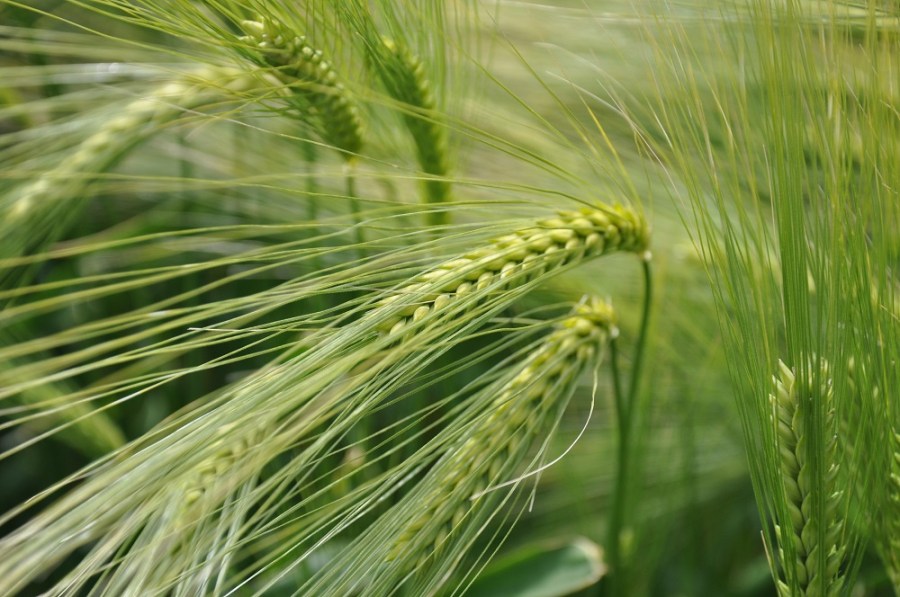It’s been a fair while since Volume topped the AHDB Cereals and Oilseeds Recommended List, but now Syngenta has two more hybrid barley varieties on the podium. CPM finds out what Bazooka has to offer.
Using hybrid winter barley as part of your blackgrass management makes a lot of sense.
Olivia Cooper
Hyvido Volume has been one of the very few hybrid barley varieties to make it onto the AHDB Cereals and Oilseeds Recommended List since 2009. But now there are another two options from the same stable, and they’re both extremely high yielding contenders.
James Taylor-Alford of Syngenta says it’s great to get hybrids back into the RL programme after four years outside it.

The RL procedures have been changed so that hybrid and conventional barleys can be compared in a fairer way, says James Taylor-Alford.
“The RL trials weren’t conducive to growing feed barley at its best – there was no emphasis on early nitrogen, which is key to both conventional and hybrid feed varieties,” he explains.
However, constructive discussions led to changes in RL procedures so that feed barley is now grown with an early nitrogen application. In addition, the baseline for automatic recommendation is now an average of the top hybrid and conventional yields, rather than treating them separately. “It’s a much fairer process,” says James Taylor-Alford. “Hyvido Bazooka is now the highest yielding barley on the RL – and the top three positions are taken up by Bazooka, Belfry and Volume.”
Consistently outperformed
James Wroth, hybrid barley breeder at Syngenta, says that in six years of trials Bazooka has consistently outperformed Volume on all soil types and across different growing years. “It seems able to scavenge more widely for nutrients and water, and return a consistent yield year-on-year. The fact it’s also performing well across the EU suggests it’s really quite an adaptable variety,” he says.
“Our breeding programme is EU-wide, which gives us reassurance that the parents are widely adapted to suit different seasons and climates.” Bazooka is a three-way cross, taking the best characteristics of two female lines and one male line, while Belfry is a straight two-way hybrid.
James Wroth reckons Belfry is ideally suited to first-time growers of hybrid barley, with Bazooka better for those who know how to really push hybrids for yield. “Belfry is more aesthetically pleasing in the field – as a three-way cross Bazooka is always going to be slightly less homogenous, but the results are there.”
David Waite, northern seed manager at Frontier Agriculture, reckons Bazooka could take about 40% of the firm’s hybrid barley seed sales this year. “The only reason I don’t think it’ll take more is because I think we’ll have limited seed availability.”
Although Frontier has sold other hybrid varieties in the past, Bazooka looks to be stronger than the rest. “It’s 3-4% higher yielding than Volume, which was pretty high yielding in the first place. The only criticism of Volume is its tendency to brackle halfway up the straw, so the ears end up very low to the ground – but early data suggests that Bazooka doesn’t have that trait.”

David Waite reckons there’ll be limited seed availability of Bazooka
Hybrids now make up just over a third of Frontier’s winter barley seed sales, and David Waite reckons that market will continue to grow. “Six or seven years ago hybrids really started taking hold in Aberdeenshire and their popularity is spreading.”
Traditional malting barley growers will continue to supply that market on contract, but as demand for winter malting barley shrinks, more and more farmers will look to the feed sector, he adds. “The yield gap between malting and feed varieties is approaching 20% now, so there’s not a lot of point in growing malting barley for feed.
Try a field
“Farmers who like two-row varieties should try a field of hybrid alongside – you can mix it in the barn as it’s all feed. That’s what people have been doing further north, and that’s why its popularity has spread.”
In the past, six-row varieties have suffered from low bushel weight and small grain size, but newer breeding and management has now bridged that gap. “Bazooka’s bushel weight is now on par with the two-rows. They’ve sorted the straw strength, added yield and boosted grain size – it really is a bit of a no-brainer.”
One of the only downsides is the price of seed. “It’s about £30/ha more expensive to buy than conventional barley,” says David Waite. “But if you get 10% more yield, at £100/t, that’s £75/ha on the bottom line. Most varieties tend to have a downside but Bazooka doesn’t really have any obvious weaknesses. The only thing is that it’s likely to sell out by Cereals, so get your seed order in quickly.”
Despite the low feed barley prices, Jamie Marshall-Roberts of Syngenta reckons the return on investment makes growing a hybrid worthwhile. “With low commodity prices you really need to push for yield – and a hybrid winter barley is more attractive than a second wheat, especially when it comes to blackgrass control,” he adds. “That’s one area I’ve really enjoyed working on – the reduction in blackgrass plants and seed is amazing.”
AICC agronomist Patrick Stephenson wouldn’t advise sowing any winter cereal on a really bad blackgrass field. “But using hybrid winter barley as part of your blackgrass management makes a lot of sense.”
Hybrids are slightly different to grow than conventional varieties, so farmers need to follow agronomic advice to get the most out of them, he adds. “But don’t be a disciple to the advised seed rate of 200 seeds/m² – with hybrids the cost of seed is the largest stumbling block, especially with feed barley prices below £100/t.” Farmers should consider the soil type and seedbed, and adjust the seed rate up or down accordingly.
Getting in with an early nitrogen application is absolutely critical – failure to get it on can slash yields by 15-20%, warns James Taylor-Alford. “Even in a warm winter like we’ve just had, where crops are looking really green, you still need to feed them.”
Although Bazooka has good disease resistance, Jamie Marshall-Roberts still recommends a robust fungicide programme featuring SDHIs to maximise the green leaf area, and therefore yield potential. “But if you don’t want such intensive inputs it’s a very robust variety, that’ll perform well in wet weather areas.”
Hybrids tend to stay clean early on, as they have good net blotch and rhynchosporium resistance, which eases the pressure at T1, says Patrick Stephenson. “However, you do need to keep an eye on mildew and brown rust later on – at T2 hybrids have a bigger leaf and you want to use that for maximum grain fill.” He advises redistributing the fungicide spend to 50:50 between T1 and T2, rather than typically 60:40 for conventional varieties.
Bazooka is tall, so it’ll require a full plant growth regulator (PGR) programme comprising early Moddus (trinexapac-ethyl) and Cerone (2-chloroethylphosphonic acid) later on. “The use of SDHIs to minimise brackling is also very important – if you’re trying to maximise yields by applying lots of nitrogen, you do need to think about the risk of lodging,” says Patrick Stephenson.
Straw yield
In a high lodging year farmers might be better off with Belfry, which has shorter straw, says Barry Barker, national arable seed product manager at Agrii. “There’s very little difference between the two other than that.”
It’s the crop’s impressive consistency that helps to back up Syngenta’s yield guarantee, whereby it will pay growers £60/ha if Bazooka fails to yield at least 0.5t/ha more than conventional varieties on three local split-field reference sites. “I think the variety stands up in its own right and doesn’t need a marketing gimmick, but if it’s at no extra cost to the grower then it’s a nice comfort blanket,” says Patrick Stephenson.
For mixed farmers, the straw yield is a particular bonus, he adds. “If you’re producing 10t/ha of grain you’re also producing 10t/ha of straw, which can be very useful. But if you min-till or no-till afterwards then that’s something you need to be aware of.”
Gleadell Agriculture sold more Bazooka than Volume seed last year, according to seed manager Chris Guest. “That was partly because Volume supplies were tight, but I think Bazooka will certainly maintain its position as the widest grown hybrid barley.”
Last year it took 28% of the hybrid market, with all hybrids making up about a quarter of the certified seed area of winter barley. “Malting barley now makes up less than 15% of the acreage, and as people get more used to using hybrids they’ll continue to take more of the market. Winter barley is useful under the three-crop rule and as an entry for oilseed rape. The only concern is the size of the market – as a feed barley the market is limited, and we do need to export.”
Barry Barker reckons Bazooka is in pole position to replace Volume, which has been on the market for a number of years. “The yield isn’t vastly different, but it does have better disease resistance, particularly for rhynchosporium, and that’s a hot topic at the moment,” he says.
Despite their similarities on paper, Bazooka looks considerably cleaner than Volume in the field this year, says Chris Guest. However, the past two growing seasons have been particularly benign, so farmers won’t have seen the best that newer hybrids should have to offer. “It’s really their ability to perform in a challenging season that makes them stand out, although anyone growing malting barley in the same rotation may need to beware of six-row volunteers.”
Volume was really the first hybrid to have the yield and consistency that farmers are after, says Patrick Stephenson. “Since then all the other hybrids have been variations around a theme – but Bazooka is a real step forward.”
Looking at its disease resistance scores, the weakest appears to be for mildew, scoring a five on the RL, says Chris Guest. “However, Glacier and Tower score three and five, respectively. There are some pretty good mildewicides out there so unless we lose a load of chemistry it’s not too much to worry about.”
Farmers should also be aware that they won’t be able to farm-save seed, warns Barry Barker. “Any F1 cross will revert back to its parent type if sown again, so if the parents are very dissimilar to each other you’ll get varying maturity, heights, and so on. You’ll also lose the hybrid vigour – whatever you sow, it won’t be Bazooka.”
Although the marketing of new varieties was held up by negotiations with AHDB over the RL, Syngenta hasn’t delayed its hybrid breeding programme. “We’ve invested £4m extra over the past three years and we’re absolutely confident that it’s going to bring some significant advantages,” says James Taylor-Alford. “There are some really exciting varieties in the NL1 and NL2 trials stages – in two years’ time there’ll be varieties with further significant yield advantages and improvements in specific weight.”
Barley yields smashed for Derby grower
Charles Edwards, whose family farms at The Limes Farm, Lullington, Burton upon Trent near Derby, was already impressed with the previous generation of hybrid barley. Last summer, he smashed his typical yield of 7t/ha from conventional winter barley with Volume, grown for the first time.
Now, with a number of improvements from Bazooka over Volume on the RL, he sees it as an even more attractive option. “We’re driven by yield,” he explains. “We can get 10t/ha from wheat but struggle to reach 7.5t/ha with barley. But the Volume did 10t/ha over a weighbridge.”
This year, all 30ha of the farm’s hybrid barley are in Bazooka. And it looks even better in the field than Volume did last year, he says. “It’s tremendous. It looks more even.” As well as its extra yield, the improved resistance to rhynchosporium and lodging of Bazooka are also welcome, as too is the fact that it shares Volume’s early maturity.
“Volume was very early ripening – we combined it on 12 July at 13% moisture,” says Charles Edwards. “It also stood up well – that’s very important because when a crop goes down it doesn’t yield and it becomes a problem drying it. The less we have to dry the better, while earliness helps cashflow.”
With soil type varying widely on the farm, from light sand to red clay, the ability of hybrid barley to perform in different growing environments, thanks to its vigorous growth, is another benefit.
“If Bazooka grows as vigorously as Volume, another advantage is that we’ve a blackgrass problem, and the Volume smothered it. It grew above it and completely closed the blackgrass out.”
In addition, improved specific weight from Bazooka is welcomed, though Charles Edwards says he wasn’t disappointed with Volume. “When you think where we used to be with six-rows, the improvements are incredible. Volume produced 69kg/hl last harvest. I was amazed,” he says.
“Another bonus to us is straw, which is of tremendous value as we also have suckler cows, sheep and pigs on the farm. We normally buy straw but I didn’t buy anything last year. We had double the amount of straw we expect from barley.”




